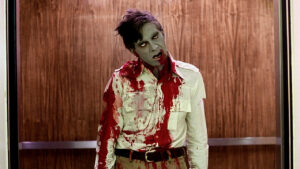[
Much has been written about Rome. Without a doubt, it is a city full of attractions everyone should visit at least once. The good news for you is that besides the standard tourist sites of the city that all roads lead to, some fit like a glove for Horror fans. In Rome, you will find historical sites with creepy settings and ghost stories (for example, the Catacombs of Rome or the Church of the Skeletons), exceptional museums (for example, the Museum of Criminology), creepy tours, and more. Only some know, but Castel Sant’Angelo, one of the iconic buildings of the city, offers a particularly dark and exciting side.
Although it is not an attraction that is necessary on every list of must-see sites in the city, we recommend that you check it out – Especially because of its connection to some of Rome’s most horrific Horror stories.
When Was Castel Sant’Angelo Built?
Like most of Rome’s significant sites, Castel Sant’Angelo was not built in a day. Castel Sant’Angelo construction started hundreds of years ago for pretty different reasons. This tall circular structure, located on the right bank of the Tiber River at a distance of a little more than a kilometer from the Vatican City, actually started as a mausoleum (magnificent burial structure) that the Roman emperor Hadrian built in 139-135 for… himself. Therefore, the place is also called today The Mausoleum of Hadrian.
Castel Sant’Angelo Rome was initially elliptical, slightly different from the cylindrical shape that characterizes it today. Access to it was via the Santangelo Bridge, also built by Hadrian, considered an imposing site. They made a small garden on the roof of the building, and in the center was a quadriga – a chariot driven by four horses – with the emperor’s statue. Hadrian died in 138, and a year later, with the completion of the construction of the burial site, his body was transferred to it along with the ashes of his wife and adopted son. It was only in the 18th century that the statue of the Archangel Michael was added to the roof of the castle, holding a sword.
Like other ancient buildings, the Sant’Angelo Castle also went through several incarnations over the years. Towards the end of the prosperity of the Roman Empire, it was decided to turn the burial site into a citadel. At the beginning of the fifth century AD, it became a fortress, and it is part of the city’s defense system: or, more precisely, part of the wall of Orleanus. In the 14th century, the building changed its shape and purpose again to a papal citadel that Pope Nicholas III linked to St. Peter’s Basilica (that is, to the Vatican itself).
The Popes of Rome used the building for their purpose: Clemens VII, for example, used it as a shelter during the Spanish King Charles V siege on Rome in the 16th century. Paul III built a magnificent residence, Leo X, a chapel for holding prayers, and the popes who came later turned the building into a prison.
Here is a short video showing the story of the castle. Take a breath because things will get darker from here.
Castel Sant’Angelo history: Torture, Murders, And Ghosts
During the Renaissance, when the building served as a prison, many for political prisoners. Many of them were cruelly tortured and executed within the castle walls or on the nearby bridge. The simple principle of torturers is so hard to digest: on the one hand, to inflict the most significant possible suffering on the torturers. On the other hand, the goal in some cases was to leave minimal physical damage or even one that was not visible.
The result is a series of horrific facilities, which you will find today mainly in torture museums such as Horror-world.com/prague-torture-museum/”>Prague or Horror-world.com/medieval-torture-museum-chicago/”>Chicago, that we have already written about on the website. For example, a rack where the prisoner was stretched on top of a wooden frame, until his joints were dislocated. Or thumb screws and similar devices; you can already imagine what they did.
The Horrific Story Of Giordano Bruno
The Italian scientist, philosopher, and astronomer Giordano Bruno was imprisoned here for six years before his execution. The reason is that his astronomical belief, some of whose ideas are accepted and empirically proven today, contradicted that of the Catholic Church. After he refused to deny his ideas entirely, he was declared an apostate. On February 17, 1600, he was dead by burning.
The Inquisition, known for its terrible torture methods, decided to show some “mercy” towards him and tied a bag of sherpa powder to his neck, meaning his torment would be shorter. On the other hand, the torturers did not give up nailing his tongue to his jaw, as a horrible symbolic act that demands from him – and unfortunately also promises – that he will not speak.
Horror-world.com/wp-content/uploads/SantAngelo-Castle.jpg 640w, https://Horror-world.com/wp-content/uploads/SantAngelo-Castle-300×201.jpg 300w, https://Horror-world.com/wp-content/uploads/SantAngelo-Castle-150×100.jpg 150w” src=”https://Horror-world.com/wp-content/uploads/SantAngelo-Castle.jpg” data- class=”aligncenter wp-image-3831 size-full lazyload”/>
Beatrice Cenci Ghost May Still Be Here
Beatrice (Beatrice) Cenci is another historical figure linked to the terrible past of the place. She was a daughter of an Italian aristocratic family who lived in the 16th century. According to the stories, her father, Francesco Sanchi, was a terrible man. He abused Beatrice and her brother to the point of incest. At the subsequent trial, she claimed that the abuses were known throughout Rome, but nothing was done because of the father’s status.
At one point, he banished the daughter to Santangelo Castle, where she, along with some of her family members and the castle’s employees, began to concoct his death plot. During one of the father’s visits to the castle, they drug him with water mixed with opium, hit him on the head with a hammer (according to some stories, a rolling pin, nail, and hammer were also involved), and threw him from the balcony, so that the death would look like an accident. The guys didn’t think about the story in depth because, in the case investigation, it was evident it was not a “simple” fall. Beatrice and his family were arrested, tortured, and interrogated to understand what happened. They were sentenced to death, although many of the people of Rome did show sympathy for them. They were beheaded on top of the bridge in front of Castel Sant’Angelo. The family, especially Beatrice, has since symbolized resistance against oppression in its most severe circumstances.
Over the years, stories have surfaced that the ghost of Beatrice Cenci still occasionally appears in Castel Sant’Angelo Rome or on the nearby bridge, holding her decapitated head in her hand. Most of these stories surprisingly appear on the night between September 10 and 11, the date of her execution. Others say they saw the ghost of Pope Clement VII, who died inside it in the 16th century. These are likely nothing more than myths, or if you want – ways to add to the place’s charm and attract more tourists. We are, of course, in favor.
Castel Sant’Angelo In Culture (But Not In Many Horror Movies. Yet)
Castel Sant’Angelo’s rich history and iconic status as a symbol of Rome’s past have made it a popular subject for filmmakers, writers, and researchers alike. The castle has taken part in the plot of several books and films that mainly take place, such as the classic romantic comedy “Rome Vacation” with Audrey Hepburn (who won an Oscar for the role) and Gregory Peck, or “Angels and Demons,” Dan Brown’s first book from 2000, just as in the more famous “The Da Vinci Code,” in “Angels and Demons,” symbology expert Robert Langdon embarks on a marathon of puzzles, deciphering symbols, and cracking codes, this time around Rome and the Vatican, to thwart a malicious plot to destroy the Vatican. Among other things, and without doing too many spoilers, the killer in this book (and the film that followed it) is hiding in Santa Angelo Castle. The castle also appears in several masterpieces, such as “The Count of Monte Cristo” by Alexander Dumas or “The Gentleman of Ballantry” by Robert Louis Stevenson.
Although the castle didn’t star in too many Horror movies, undoubtedly not familiar ones, you can find some references to it. The Spanish Horror film “The Screaming House” from 1969 takes place in a boarding school for girls, the design of which was inspired by that castle. The British Horror film “Gothic” (1986. Not to be confused with that horrible “Zootica” with Halle Berry) is very loosely based on a meeting that the author of the novel “Frankenstein,” Mary Shelley, had with the British romantic poet Lord Byron. They meet to write Horror stories, but like a real Horror story, very soon, scary things start happening, and people start dying. One of the scenes in the film takes place in the Castle of Santangelo.
The Italian film “Dellamorte Delamore” from 1994, loosely translated as “Cemetery Man.” The film, starring Briton Rupert Everett and Anna Falci, who was quite the sex symbol in the 90s and early 2000s, is about an employee of a small Italian cemetery looking for love while trying to fight resurrected corpses. Some of the scenes in the film were filmed in Castel Sant’Angelo interior, including a sequence in which the famous statue of Michael comes to life.
How Can You Visit Castel Sant’Angelo?
Over the years, Castel Sant’Angelo became a museum. Today Castel Sant’Angelo National Museum is visited not only by Horror fans. You can visit here independently, but we recommend taking a Castel Sant’Angelo tour. It is important to remember that the official tours of the place present its history and refer to some of the stories we have brought here, but their emphasis is on something other than Horror. The good news is that you can find some unofficial tours that focus on these topics, such as ghost tours.
In any case, we recommend visiting this castle or being impressed by its appearance from the outside. Castel Sant’Angelo tour goes through the five floors, each of them presenting a different side of the story; where in the middle, you will come across quite a few spectacular wall and ceiling paintings, sculptures, and restored or authentic items according to the following breakdown of Castel Sant’Angelo Museum:
Entrance floor: the display of medieval weapons
1st floor: The Mausoleum with the authentic tombs of Emperor Hadrian and his family members (unfortunately, some of the contents here have been looted over the years)
2nd floor: the prison
3rd floor: The museum contains furniture, weapons, ceramic items, art items, and more
4th floor: the luxurious residential apartments of the Popes
5th floor: the 360-degree observation deck, with the bronze statue of the Archangel Michael and a lovely beverage bar. Many note that this is one of the successful parts of the visit. You can also plan it for sunset, thus getting breathtaking views of Rome and its surroundings.
Castel Sant’Angelo Tickets
Although Castel Sant’Angelo National Museum is less famous than the most visited sites in Rome, for example, the Colosseum or the Vatican City buildings, it attracts many visitors. During peak tourism seasons, you may encounter tedious queues at the entrance. That’s why we highly recommend buying an entrance ticket in advance, which also prevents you from standing in line. You can present Castel Sant’Angelo tickets at the entrance, even through the mobile phone, and that’s it.
Castel Sant’Angelo Opening hours: Tuesday-Sunday between 19:30 and 9:00. Last entry at 18:30.
The museum is closed on Mondays as well as on January 1, May 1, and December 25
Castel Sant’angelo Tickets Price (as for 2023)
Adult (age 17 and over): 19 euros
Children (up to the age of 17): 3.5 euros
Entrance ticket (without queuing) with audio guide: 24 euros
Guided tour: 49 euros for a two-hour tour (the more recommended classic tour), or €35 for an “express” tour lasting one hour
Combined tickets: you can buy combined Castel Sant’Angelo tickets with the Colosseum, the Vatican Museum, the Borghese Gallery, and other sites at a slightly discounted price
Where Is Castel Sant’angelo?
The castle is located at Via Lungotevere Castello, 50 in Rome. You can reach it with a relatively straightforward walk from some of Rome’s must-see sites, such as the Vatican City or Piazza Navona.
Unfortunately, not all the roads lead to Castel Sant’Angelo. But you can do it with the help of Rome’s excellent public transportation:
Bus: The nearest stop, Piazza Pia, is five minutes away. Several lines reach it: 23, 62, 271, 280, 982.
Metro: There are two options. The first is to take line A to the Lepanto station, a 15-minute walk away. Another option is to get off at Ottaviano station and walk about the same distance.
Light rail: Line number 19, which runs from early morning until midnight, will bring you to the Risorgimento/S station. Pietro, which is about a 12-minute walk from the castle
You will find more information on Castel Sant’Angelo official website.
Please follow and like us:
#Castel #SantAngelo #History #Torture #Ghosts #Mystery






More Stories
Film Historian Tom Fallows On George Romero As An Indie Auteur
Found Footage: The History of Indie Horror’s Favourite Format – Horror News | HNN
Julia Garner Joins Horror Movie ‘Weapons’ from the Director of ‘Barbarian’